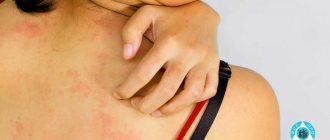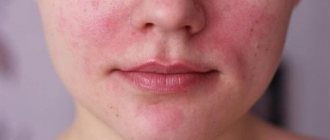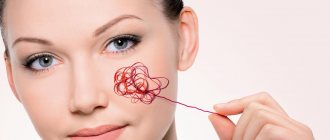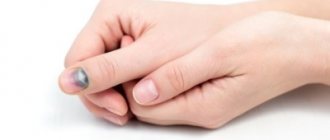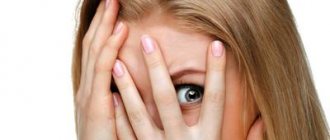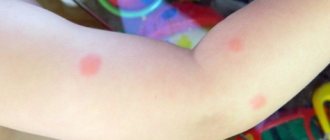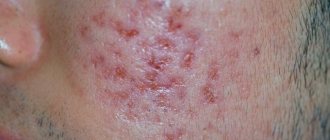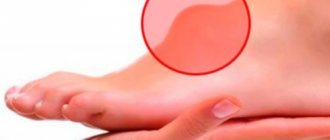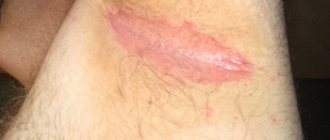Why do blackheads appear after hair removal?
Epilation involves removing only the cutaneous part of the hair, leaving the hair follicle intact. After several exposures, the skin becomes rough and the hairs become weak. All this disrupts the processes of natural hair growth. They begin to grow into the thickness of the skin, so black dots form on the legs and itchy skin appears.
If you scratch the skin on your legs and feet, various microorganisms penetrate inside. As a result, pimples or ulcers form. After healing of the wound remaining at the site of severe suppuration, an ugly pigmented spot sometimes appears.
Infections
Spots due to erysipelas
It often happens that the skin below the lower leg becomes covered with spots. This can happen with the progression of erysipelas, which occurs when the body’s protective function decreases. You can suspect the disease by the nature of the spots: they are red, with clear edges on which a ridge forms. Body temperature rises significantly, swelling, itching and pain appear. When the process is neglected, the skin peels off, and blisters form in these places, developing into ulcers that heal poorly.
To stop the inflammatory process, as well as normalize body temperature, it is recommended to take medications with antipyretic and anti-inflammatory effects (NSAIDs). The most accessible remedy would be Paracetamol. Nurofen and Ibuprofen also help well, and the complex should be supplemented with agents that suppress the activity of pathogenic bacteria, for example, Erythromycin or Ampicillin.
In the absence of damage to the skin, it is recommended to give preference to topical preparations. But it is better that all medications are prescribed by a doctor.
What is the cause of irritation after the procedure?
The appearance of rashes, itching and pain after a session of removing excess hair are quite common side effects that occur after an epilation session on the legs. Such complications create a lot of problems, inconvenience and discomfort, and the fight against them can take a long time. If you follow the cosmetologist's recommendations, the process of eliminating irritation will take at least 2-3 weeks. What is the reason for this trouble?
Red dots after hair removal appear due to inflammation
, which is damaged depending on the chosen hair removal method
- frequent procedures, carried out incorrectly, lead to the appearance of spots on the legs after hair removal,
- constant injury during a session to the nerve endings located in the fatty layer of the skin, leading to their inflammation, which over time leads to a rough surface and red spots on the skin,
- an incorrectly selected hair removal method is also one of the reasons for the appearance of redness and spots on the body,
- irritation in the form of redness may be a consequence of the skin's reaction to stress: pain caused by the procedure can provoke red dots after hair removal,
- an infection that gets into the pores during a session is not only fraught with irritation on the body, but is also extremely dangerous, so hygiene rules in this case must be followed with the utmost care before and after the procedure,
- redness of the skin may be a consequence of an allergic reaction of the body to the products used during the session. In this case, it is better to change the hair removal method and the problem will go away,
- Another reason for the appearance of dots on the legs after removing excess vegetation can be ingrown hairs.
Forms of psoriasis
The disease takes various forms:
- May affect the skin and form plaques. Occurs on the knees, feet and lower legs.
- The second type occurs in the bend areas on the back of the knee.
- The third type affects the joints and leads to arthritis.
- It can occur in the form of papules with watery filling and cause purulent lesions of the skin areas.
- Affects the nail plates. Nails peel and break.
Treatment
Acceptable cryogenic, laser, radio wave, high frequency therapy. Traditional medicine also knows how to get rid of blackheads, calluses and warts.
Here are a few recipes, such as:
- Secure the grated onion and vinegar mixture with a bandage on the leg, after covering the undamaged area of the skin with a band-aid. In the morning, clean the soles of the remains of the drug. Repeat the procedure 3-4 times.
- Moisten the dry flour generously with apple cider vinegar, place the resulting dough on top of the spike, the top of which has been cut off with a knife. The healthy area of the sole must also be covered with a plaster to avoid burns.
- Neglected or numerous formations are removed with young crushed nettles. Attach a large burdock leaf to the foot.
- Blackheads on legs are removed after shaving using a needle and tweezers. It is necessary to thoroughly disinfect the tools with alcohol, and then use them to pull the hairs out of the skin.
- A homemade scrub made from coffee grounds, birch tar, or corn flour will help prevent the proliferation of dark specks. Mix the ingredients with liquid soap or gel and massage the damaged areas daily with massage movements.
Diagnostics
To make a diagnosis, it is necessary to undergo a thorough examination.
- Laboratory tests - general blood test and biochemical analysis of plasma with kidney samples.
- Blood test for sugar.
- Collection of biomaterial (epidermis) for bacteriological seeding.
- Scraping from affected tissue to identify fungal infections.
- Instrumental examination of the venous bed for the presence of blood clots - venography.
Scraping the affected area of skin will help determine the presence of concomitant infections.
How to get rid of red and blackheads?
The appearance of black or red dots, as well as other types of irritation, significantly affects aesthetics. In most cases, the dots are clearly visible, and therefore the girl cannot wear dresses and skirts. The question of how to get rid of this problem worries all the fair sex who have encountered it, especially in the summer.
How to get rid of black dots?
If the cause of blackheads lies in ingrown hairs, you can solve it with tweezers. First, the instrument must be disinfected, and then carefully pick up the hair and remove it. Under no circumstances try to squeeze them out with your nails, as this can cause an infection, which will lead to the appearance of ulcers. If the hair is deep, you can get it out with a needle. Don't forget to disinfect it too.
If the problem is global in nature, that is, there are too many ingrown hairs, you should change the hair removal method. Salon procedures help achieve good results:
- laser hair removal,
- photoepilation,
- elos hair removal and so on.
You should also change the method of hair removal if blackheads remain immediately after shaving (remnants of roots).
How to solve the problem of red dots?
For some girls, red spots on the legs after shaving disappear on their own after a couple of hours. If this does not happen, the problem can be solved using pharmaceuticals or traditional methods.
Antiseptic ointments (Malavit, Boro Plus, Actovegin, etc.) will help eliminate irritation. They must be used according to the instructions. Usually it is enough to lubricate the damaged tissues in the morning and evening for a couple of days.
After hair removal, cortisone ointment helps get rid of redness and red spots. The drug has anti-inflammatory and antiseptic properties. If you notice irritation on your legs after shaving, immediately apply hydrocortisone ointment (1%) to them. Unpleasant symptoms will go away almost instantly - the red dots will become less noticeable, and the itching and burning will disappear without a trace.
Aspirin also helps remove red spots on the legs. You need to use it like this:
- Grind several acetylsalicylic acid tablets into powder.
- Add some glycerin.
- Stir.
- Wipe the irritated areas with the prepared product.
Aspirin with glycerin have good antiseptic properties. Thanks to this, they quickly get rid of red spots, and also moisturize the skin and promote their rapid recovery.
Folk remedies will also help with irritation:
- Spots and dots that appear after waxing will help remove lotions from herbal decoctions. For these purposes, you can use chamomile, celandine, calendula and other herbs that have anti-inflammatory and healing properties.
- Aloe also helps. Wash the leaves of the plant and cut them lengthwise. Apply the juice of the plant to the affected areas of the skin. Repeat these steps 2-3 times a day until the dots disappear completely.
- You can also soothe irritation with baby powder. You just need to sprinkle the irritated epidermis with talcum powder, and after a while carefully remove it.
Spots on the legs after hair removal are a common problem for many women today, since hair removal is the most common and popular method that has such unpleasant consequences.
To get rid of unwanted hair removal results, you can use a solarium
To find a way to get rid of red dots after hair removal, you need to listen to the advice of experienced cosmetologists:
- the first thing to do is to stop the sessions of removing excess vegetation,
- Medicines will also help solve the problem, for example: medicinal cortisone ointment, which has healing and anti-inflammatory properties. This drug is recommended to be used before bed, applying the ointment to the steamed dermis, when the pores are maximally opened and ensure complete penetration deep into the sebaceous ducts,
- Massage can be a good remedy for pressure points. It activates blood circulation and ensures restoration of metabolism, which ultimately leads to an acceleration of the healing process,
- A visit to the solarium will help relieve redness on the legs after hair removal, especially if it is done regularly. Ultraviolet rays will create conditions to enhance the effect of the massage, and tanning will help hide the unpleasant phenomenon.
The occurrence of itching and redness after the procedure requires immediate action. To solve the problem of how to get rid of red dots after hair removal, using special products will help:
- the use of disinfectants in the form of hydrogen peroxide and chlorhexidine immediately after the end of the session. After applying such drugs, the risk of redness or irritation, as well as infection, is reduced significantly,
- the use of anti-inflammatory creams and ointments to promote healing of inflammation. Popular among them is “Panthenol” (its analogues),
- If there is a small area of irritation, you can use a cream based on natural ingredients, including baby cream, or powder.
It is recommended to use folk recipes to solve the problem, for example: medicinal plants or herbs (calendula, chamomile or celandine). Lotions with decoctions of these herbs on problem areas will help get rid of redness. It would also be useful to use aloe juice - cut a leaf of the plant and apply the pulp to the problem area.
When removing vegetation with a razor, you should not repeatedly run the machine over one place. This action will most likely cause a problem. If this method causes concern about the growth of coarse hair, then cosmetologists advise using depilatory creams. They will help you painlessly and quickly deal with excess hair and maintain a smooth body for several weeks.
As a rule, each of these remedies gives positive results. Any hair removal method can lead to undesirable consequences in the form of redness. Therefore, before starting the session, it is worth understanding that only strict adherence to the rules and advice of cosmetologists will make it possible to avoid irritation after the procedure for removing excess vegetation. Every woman today can find a suitable hair removal option for herself that will not create problems during and after the procedure.
How to properly prepare for the procedure to avoid irritation?
Activities that must be carried out during preparation for the procedure:
- To open the pores, steam the area of intended epilation, as the hairs will be pulled out easier and faster, without creating a risk of side effects (irritation, redness). This method of preparation is needed when using cold wax, epilator or tweezers,
First of all, to combat complications after hair removal, you need to stop the procedure for a while.
- clean the surface of the skin, disinfect and dry. Only after this can you begin the process, and the tools and hands must be perfectly clean, and hair removal products must not be expired,
- Each epilation zone requires its own methods of hair removal (electric epilator - for legs and arms, for the face - tweezers or wax, for intimate areas it is better to use a hardware procedure in the salon).
For skin care after a session, there are also recommendations that must be followed:
- refrain from taking a bath or shower for at least a day,
- Do not apply cosmetics to the treated areas of the face for at least 1-2 days,
- when leaving the room into the open air, you need to apply a protective agent (against ultraviolet rays) to your body,
- you cannot use the services of a sauna, bathhouse or swimming pools (from a day to two),
- It is advisable to wear underwear and clothes made from natural fabrics.
Preventing the formation of blackheads
The procedure for removing ingrown hairs on the legs is not accompanied by pain, but it is unpleasant and time-consuming. It is better to try to prevent their occurrence. To this end, follow a few simple rules.
- Steam the skin on your calves and feet a day before hair removal using any method (including shaving). Then treat it with a scrub
- The next day after hair removal, also use a scrub.
- Treat your skin with a scrub once every 1-1.5 weeks
- Before removing ingrown hairs, also try to take a shower and steam your calves and feet. The pores on the skin will expand, the skin will be soft, and the hairs will be flexible
- When removing hair using an electric epilator, carefully ensure that its blades are clean.
- Use hair removal wax only once
- In some cases it makes sense to wait. The skin and hairs gradually “get used” to hair removal and the black spots will disappear on their own
Types of rashes, rashes and spots on the heels and feet. Causes and treatments
When spots appear on the heels at any age, this indicates a sign of an unhealthy body, causing discomfort and unpleasant sensations. Heels may peel, itch, and hurt when walking. Similar manifestations often appear in people who have previously been exposed to long-term exposure to low temperatures on their heels.
In addition, red heels appear in those who have increased skin sensitivity and wear uncomfortable shoes. Sometimes redness of the heels indicates serious pathologies - diabetes, mycosis. To eliminate the problem, you should not carry out independent treatment, but consult a doctor.
Types of rashes
Rash refers to a broad medical concept. A large number of reasons lead to its appearance. Rashes are pathological elements on the skin and mucous membranes, differing in color and texture.
Where to go if a rash appears
With this symptom, people often consult a dermatologist or surgeon. After the required studies have been completed, a referral to a specialist who specializes in treatment may be given, who will prescribe the correct treatment.
